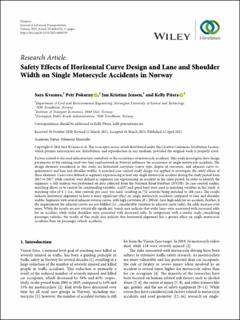| dc.description.abstract | Factors related to the road infrastructure contribute to the occurrence of motorcycle accidents. This study investigates how design parameters of the existing rural two-lane road network in Norway influence the occurrence of single motorcycle accidents. The design elements considered in this study are horizontal curvature (curve type, degree of curvature, and adjacent curve requirements) and lane and shoulder widths. A matched case-control study design was applied to investigate the safety effects of these elements. Cases were defined as segments experiencing at least one single motorcycle accident during the study period from 2013 to 2017, while controls were defined as segments not experiencing an accident in the same period. In order to identify the segments, a GIS analysis was performed on data collected from the National Road Database (NVDB). In case-control studies, matching allows us to control for confounding variables. AADT and speed limit were used as matching variables in this study. A matching ratio of 4 : 1 (i.e., four controls per case) was used, resulting in 752 controls being matched to 188 cases. The results indicate horizontal alignment to have a more significant effect on single motorcycle accidents compared to lane and shoulder widths. Segments with several adjacent reverse curves, with high curvature (R < 200 m), have high odds for an accident. Further, if the requirements for adjacent curves are not fulfilled (i.e., considerable variation in adjacent curve radii), the odds increase even more. While the results are not statistically significant, trends seen indicate that wider lanes were associated with increased odds for an accident, while wider shoulders were associated with decreased odds. In comparison with a similar study considering passenger vehicles, the results of this study also indicate that horizontal alignment has a greater effect on single motorcycle accidents than on passenger vehicle accidents. | en_US |

